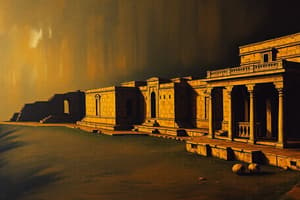Podcast
Questions and Answers
What time period did the Harappan civilization flourish in?
What time period did the Harappan civilization flourish in?
- 3000 BC - 1500 BC
- 2600 BC - 1900 BC (correct)
- 3500 BC - 2500 BC
- 2000 BC - 1000 BC
What rivers were mentioned as locations for early farming communities in ancient India?
What rivers were mentioned as locations for early farming communities in ancient India?
- Ganges and Brahmaputra
- Indus and Ganges
- Indus and Saraswati (correct)
- Yamuna and Godavari
What distinguished Harappan cities in terms of urban planning?
What distinguished Harappan cities in terms of urban planning?
- Absence of drainage systems
- Circular structures
- Wide streets intersecting at right angles (correct)
- Irregular street patterns
What was a significant feature of Harappan society's economy?
What was a significant feature of Harappan society's economy?
What was a key aspect that characterized Harappan culture in terms of technology?
What was a key aspect that characterized Harappan culture in terms of technology?
What does the urban planning of Harappan cities suggest about the society?
What does the urban planning of Harappan cities suggest about the society?
What was a significant industry supported by Harappan agriculture?
What was a significant industry supported by Harappan agriculture?
Which exotic material did the Harappans have access to due to their seafaring capabilities?
Which exotic material did the Harappans have access to due to their seafaring capabilities?
What was a common theme among the religious structures unearthed in Harappan territory?
What was a common theme among the religious structures unearthed in Harappan territory?
What led to the sudden collapse of the Harappan civilization around 1900 BC?
What led to the sudden collapse of the Harappan civilization around 1900 BC?
Which material was NOT mentioned as being used for artistic representations by the Harappans?
Which material was NOT mentioned as being used for artistic representations by the Harappans?
What does the decline of the Harappan civilization mark in Indian history according to the text?
What does the decline of the Harappan civilization mark in Indian history according to the text?
Flashcards are hidden until you start studying
Study Notes
History of the Harappans - A Snapshot of Ancient India
The history of ancient India is often synonymous with the story of the Harappans, a civilization that flourished between 2600 BC and 1900 BC. This era was marked by a series of events and developments that have left indelible impressions on our understanding of human history. Let's take a brief journey into this fascinating past.
Origins and Early Developments
The roots of the Indus Valley Civilization can be traced back to around 7000 BCE when farming communities began to establish themselves along the banks of rivers like the Indus and Saraswati. By the late third millennium BCE, these settlements had evolved into a distinct culture characterized by urban planning, trade networks, and advanced technology.
Urban Planning and Cities
One of the most striking aspects of Harappan cities was their layout and infrastructure. Each city was meticulously planned, with wide streets intersecting at right angles, uniform brick houses, and well-organized drainage systems. These features suggest a high degree of social organization and administrative efficiency—a reminder that even thousands of years ago, humans were capable of remarkable feats of engineering and civic planning.
Trade and Economy
Harappan society thrived on extensive trading activities. They traded goods over vast distances, from Afghanistan to Gujarat and southwards into Tamil Nadu. Their economy was based largely on agriculture, which supported the growth of several industries such as cotton textiles, copper smelting, and pottery production. Their seafaring capabilities allowed them to access exotic materials like lapis lazuli from Afghanistan.
Culture and Society
Harappan artifacts reflect a vibrant cultural life. Seals carved with intricate designs showcase their artistic skills, while terracotta figurines depict both male and female forms wearing elaborate jewelry, indicating a strong sense of class distinction among citizens. Religious practices seem to have been centered upon water deities, and religious structures have been unearthed throughout their territory, including Dholavira, Mohenjo Daro, Rakhigarhi, Lothal, Kalibangan, and other sites.
Decline and Aftermath
For unknown reasons, the Harappan civilization suddenly collapsed around 1900 BC. Some theories attribute this decline to environmental factors, such as climate change or overuse of resources. Others speculate that migration might have played a role, either due to population pressure within the region or due to invasions from neighboring groups. Whatever the cause, it marks a turning point in Indian history, leading to regional kingdoms and tribal cultures until the rise of empires during the Iron Age.
In conclusion, the Harappan civilization serves as a testament to humanity's capacity for innovation, urban planning, and international trade. It offers valuable insights into how societies evolve and adapt to changing circumstances, leaving behind enduring legacies that continue to fascinate historians and archaeologists alike.
Studying That Suits You
Use AI to generate personalized quizzes and flashcards to suit your learning preferences.




